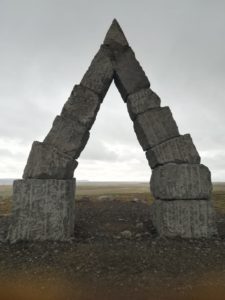Sacred nature in Iceland by Rosie Corner
Helgafell - Sacred Mountain
Every year, the Alfred Toepfer Natural Heritage Scholarship supports the work of young conservationists in Protected Areas across Europe. In this article, Rosie Corner, Place Plan Officer for Shropshire Council, and winner of the Scholarship in 2020 details her research into Sacred Natural Sites. Her report is available at the bottom of this page.

Article written by Rosie Corner.
In June 2022, with the generous support of the Alfred Toepfer Institute, I spent two weeks in Iceland researching my report into Sacred Natural Sites: areas of land or water having special spiritual significance to people and communities.
My trip took place in Þingvellir National Park, Vatnajokull National Park and Snæfellsjökull National Park as well as many more of Iceland’s 120+ protected areas.
I believe that sacred nature should matter to protected area managers because:
- More than three quarters of the world’s population consider themselves to hold some sort of religious belief. When people of faith visit protected areas they bring their belief systems with them, and this can impact how they perceive, experience and act towards the natural world. By building their religious literacy, protected area managers can engage better with people of faith and build towards better outcomes for nature.
- Protected area managers have the power to influence people’s beliefs about the value of the natural world. Regardless of whether or not a visitor to a protected area considers him/herself to be religious or spiritual, they have the ability to perceive nature as sacred: something which is too important to be changed. People who perceive their natural surroundings as sacred are more likely to take care of them.
The report you are about to read provides an introduction to the many ways in which a spiritual reading of the landscape and its non-human inhabitants can aid protected area management and enrich the visitor experience. The report is structured around Ninian Smart’s ‘dimensions of the sacred’: a framework which captures the broad and encompassing nature of religion. These are:
- Philosophical
- Ritual
- Narrative
- Experiential
- Ethical
- Social
- Material
In each section, I describe how these dimensions can be seen at play in protected areas and present an Icelandic case study to illustrate my ideas. The report ends with a manifesto of ten ways in which seeing nature as sacred can enrich protected areas.
Sacred nature in protected areas: A Manifesto
- Make the retail offer sustainable and meaningful. Every souvenir purchased from a protected area should become a treasured possession that encourages repeat visits and in depth engagement.

Artic Henge
- Organise and promote activities that cater for visitors of different faiths.
- Accept that engaging spiritually is one of the many different ways for visitors to experience a protected area. The more diverse the experiences that are available, the better the visitor offer.
- Make your code of conduct clear, attractive and connected to people’s spiritual value systems.
- Recognise that people are more likely to donate their time, energy and money to causes that resonate with them on a spiritual level.
- Provide places for people to experience complex emotions during challenging life stages.
- Acknowledge and promote the fact that protected areas are some of our greatest pieces of cultural heritage and markers of nationhood.
- View all protected area stakeholders as part of a congregation of owners, users and facilitators.
- Create opportunities for people of all faiths and none to celebrate important life events in inspirational surroundings.
- Under the Human Rights Act everyone has the right to freedom of thought, conscience and religion. When nature becomes sacred, access to it becomes a human right.
You can find all previous winners of the Alferd Toepfer Natural Heritage Scholarship here.